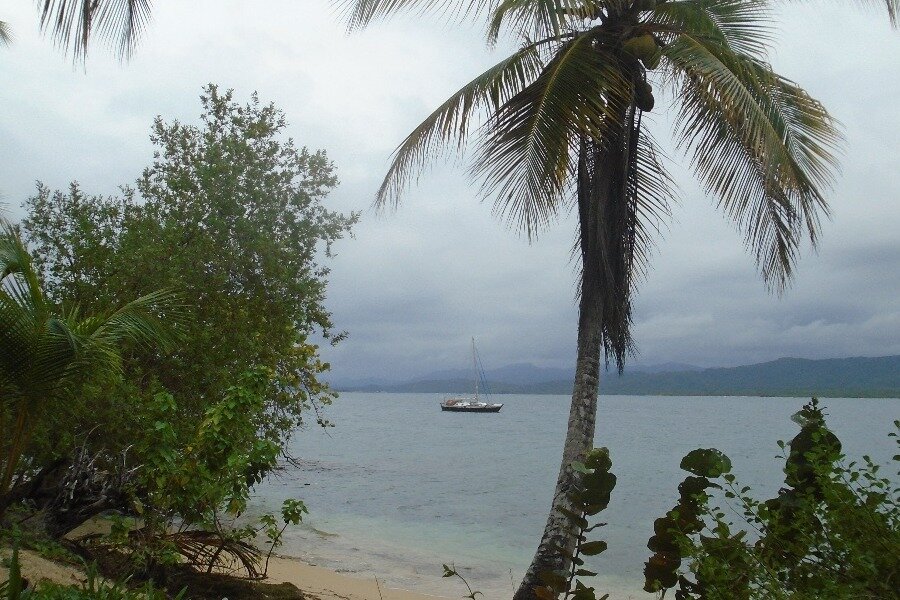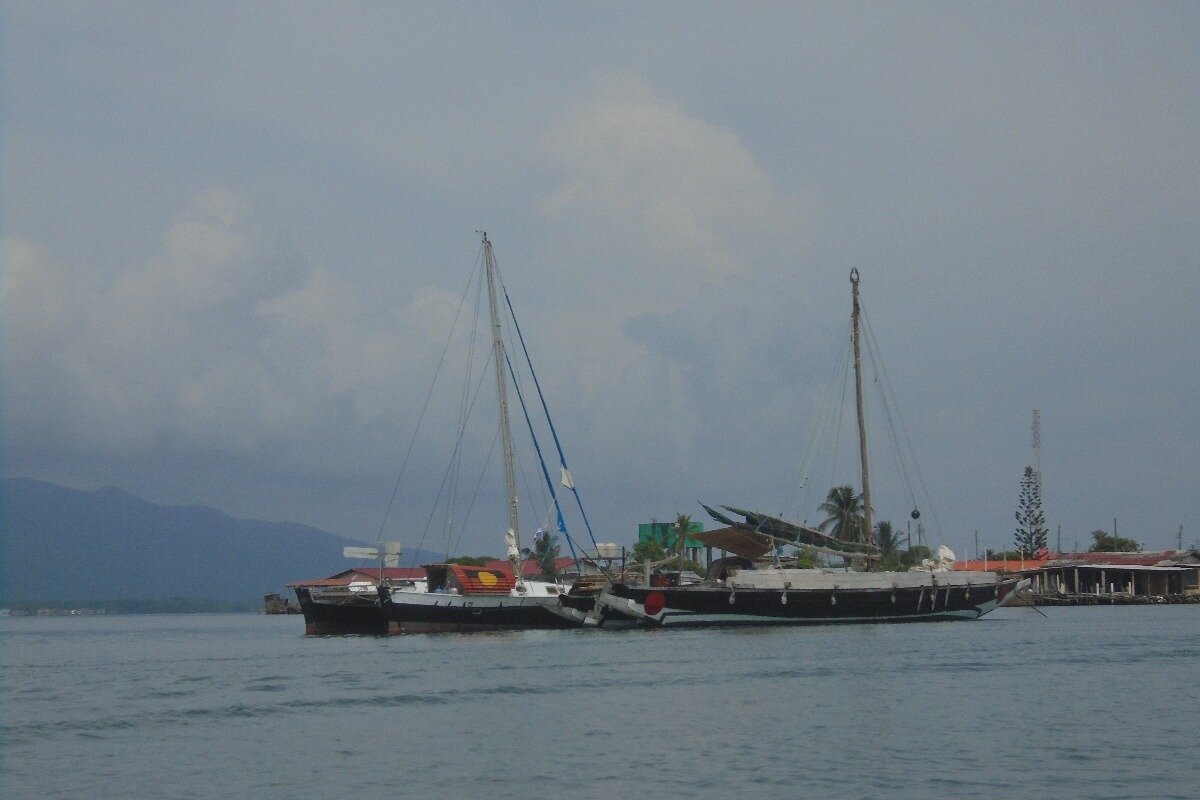It always seemed so far, so I went...
The sail to the San Blas was mostly uneventful, and the time we spent there was the same. It took us two days and one night to reach Chichime, and it was my first sail alone. Ontong Java arrived first, and I followed just behind. We anchored in our special spot, at a depth of less than five feet. This archipelago is where I met Hans, two years prior. It was nice to be back.
For the next two weeks we sailed through the turquoise waters, stopping at our favorite coconut covered islands. Though each were short, those two weeks consisted of my second time sailing alone, and my third, and my fourth, and my fifth, etc… I was getting further acquainted with the workings of my boat, and practice in the art of singlehanded sailing.
We were on our way out of the San Blas, pointing direction Colombia, when just a couple of hours before sunset, the weather seemed to be deteriorating. We made a detour, and our last stop was the tiny island called Diablo, on top of which sat a cramped little village. My nerves hit. Colombia… Colombia had always seemed so far away to me. Yet there I was on my last night at anchor in Panama, telling myself Colombia was just over the horizon. I didn’t make it on land to visit the over populated, favela-like huts and trash filled streets where short, sombre Kuna people lingered; instead I stayed inside my head going over all the things that I now knew, and the things I still didn’t, trying to calm myself.
The next morning we were off, due East with 145 miles to go. As we left the protection of the islands for the most tucked away corner of the Caribbean Sea, the swell became more pronounced, and Mara Noka followed each crest and trough with one hull and then the other. I quickly became seasick. My galley felt even more cramped and hot than usual, yet somehow I managed to boil a pot of water without fainting. I felt terrible. I added an MSG-filled packet of chicken noodle soup to the water and dug through my food stores looking for soda crackers. Ten minutes must have passed, but it felt like ages. Eventually I scrambled back upstairs, managed to eat, called Ontong Java on the radio to inform Hans of how I was doing, and then climbed into my doghouse (sleeping quarters above deck) and immediately passed out.
That day and the following were filled with the same: fighting seasickness, trying to make food, and constantly receiving commands from Ontong Java to either “fall off” or “go higher.” Rest was fleeting.
After a calm night, I awoke on the third morning with the the sun peaking over the horizon. The wind started to swing and come from behind, which meant I had to steer. As I sat in my cockpit, I was close enough to make out the details of the approaching island, circular of about one mile wide, covered in green. Houses and hotels set above low-lying cliffs, and different styles of pangas lined the available shoreline. Being a few miles behind Ontong Java, I watched her magnificent black crab-claw sail zoom behind the lee of the island. I followed along, slowly, behind. I had made it to Colombia. As I rounded the lee, a panga sped away from land and gunned it straight for me. Two young men came up to my side, as I was still sailing in, and shouted at me, “estás todo bien?” “Si claro, gracias,” I responded. They asked me if I needed anything: water, fuel, food. I told them sleep. They went on their way, and I proceeded to drop anchor. My aim was bad, and I shot into the wind too early. I began to drift backwards quickly. There were fishing boats and a rocky outcrop behind me, and I didn’t think I’d have time to start my engine so I went to the front, unraveled the chain, and let my 30kg Bruce plunge into the water. Hans shouted at me from some distance aways and told me to come closer. I was exhausted and couldn’t fathom lifting the anchor again. I stayed.
I found Fuerte to be beautiful, and though a very miniaturized version, the flora and landscape reminded me of where I come from in Brazil. The land was divided up into plots, separated by barbed wire fencing. Some plots had cows, some cane sugar, and some filled with mango trees. I could tell the people found it interesting that we were there, as the island does not get visited by yachts frequently, yet they were very stoic and carried on with whatever work they were doing, only pausing to glance up and greet us with a drawn-out “buenas.”
One day during our stay, while using WiFi at a local guesthouse to check the weather, we noticed a huge black rain cloud approaching. I had left my boat open, and it was several hundred yards away. I noticed a panga getting ready to depart, and ran down the beach. I hailed them back and asked if they could give me a ride to the boat. The driver agreed and I hopped in. Thunder boomed over our heads, and just thirty seconds after leaving, the driver pulled the boat onto the next beach. “Sorry, but we have to wait out the rain before we keep going. Too dangerous,” he said in Spanish. “But I have to get there before the rain!” I implored, but no was the answer. I hopped out of the panga, and ran down the beach towards where Ontong Java’s dinghy was perched up against a wall. It started raining. I dragged the dinghy into the water, jumped in, and rowed. It rained, and I rowed, and it rained. Once I finally made it to the boat, I closed all of my hatches and portholes, and climbed downstairs to dry off. As soon as I closed the hatch over my head, it seemed, the rain stopped. Of course. Later, I rowed back to the guesthouse under the sun and bright blue skies, and it was as if I had imagined it all. We remained at anchor for most of the week and enjoyed every moment, but we needed to keep moving. It was already June, we had to make it to Bahamas, and Hans still wanted to cross the Atlantic that year. So, after gathering a couple boxes of mangoes, we departed.
We were making our way to Cartagena, but the Colombian coast, like the Panamanian, is not the easiest to sail―currents, choppy seas, and either too much wind or not enough impede progress. The morning we left Fuerte we had a nice breeze, but it did not last long. By lunch time the seas were flat and my sails flapped back and forth fighting to fill up with wind. Ontong Java motored closer, and Hans jumped into the water on his surfboard and paddled over, leaving his crew, the carpenter Marius, on board. The small amount of wind there was, was coming from behind. He helped me set up a sheet-to-tiller self-steering system, which made absolutely no sense to me and told me to try to fly my spinnaker, a light-weight balloon sail―two more things added to the list of many which I had not done before. After fighting my usual heart palpitations, nervous nausea, and sweaty hands, I set up the sail on deck, attached the sheets and pulled on the halyard. The white, red, and blue sail flew up the mast, and filled with air. Hans helped me adjust it before hopping back into the water, and paddling back to his boat.
For the rest of the afternoon Mara Noka glided downwind, and I lay on deck pulling at the self steering string to keep course because I did not know how to adjust it. By sunset I was approaching land. The golden hues reflected off the shallow water, of less than 100 feet, and turned the blue water a turquoise color. It was time to take the spinnaker down… but as with most things in my life at this time, I had no clue what I was doing. I was told to let the foot fly and then drop the halyard, so that’s what I did. But when the sail came loose and collapsed back onto itself, it got caught on some bolts which we sticking too far out of my front roller furler. I knew that I should go untangle it before I made anymore moves, and I should do it quickly. But I panicked and let the halyard fall even more. Crrrrrrrrrrrrrrrrr. The spinnaker came closer. Not because it came loose, but because there was now a four foot long tear in the delicate fabric. One and done―a spinnaker is very difficult and costly to repair, so I knew it would be awhile before I would be able to get that done, and until then, it would be out of use.
We stayed a night in Tintinpan and tacked our way to Islas del Rosario the next day for another nights’ rest there. That left us one more passage to Cartagena―a short one, with only 12 miles to the entrance of the port. The wind was fluky, and for much of the time we motored. Despite the grey skies, hoards of power yachts passed us on either side. I deduced they must be heading out of Cartagena for a day on the islands which we had just left. They ranged from 20 to 50 feet, all blasting reggaeton at the highest possible volume, with voluptuous Colombian gals at the bow in tight bikinis, sipping on Aguilas or aguardiente. The number of boats we passed was truly impressive―it must have been more than 200 by the time we reached the entrance to the port of Cartagena.
As we entered the breakwaters, the wind had ceased completely. It was late afternoon, there was still not a ray of sun poking through the clouds, and some of the boats we had passed earlier in the day were now returning. After coming from the natural isolation of the Caribbean coast of Panama, and most of Colombia leading up to Cartagena, the cityscape of skyscrapers, condominiums, and odd modern architecture which now surrounded me was almost shocking. The mere size of the Bay of Cartagena was intimidating; being close to 6 miles from the entrance to the anchorage. It took me over an hour to reach the bundle of boats which were lying at anchor. Ontong Java had arrived first, as per usual. I motored up to his side and Hans tossed me a line so I could tie up. Being alongside was short-lived; we had not anchored far enough away from the loading docks of the port, and as soon as the first tug boat zoomed by, a wake resembling those I experienced in the Panamanian port of Colon came for our sides. Waves and catamarans rafted do not go well together. We decided we would separate, Hans pointed out a spot in the multitude of boats where I should drop anchor, and I went. Nightfall came shortly after, and I went to sleep that night in my home at the center of one of the busiest ports in the Caribbean.


